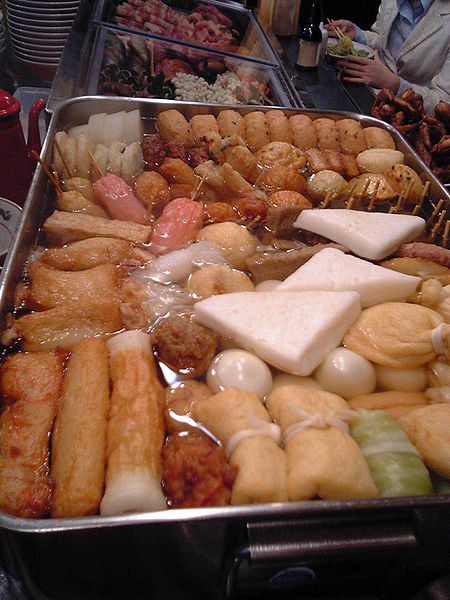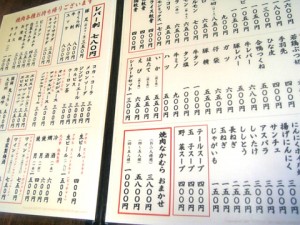If you ever learned how to order food in a classroom and/or textbook, let me assure you that is not how it’s done. Because Japanese employs a relative system of politeness, as a customer of the food establishment, you are automatically on top of the societal ladder regardless of your actual social status. Of course, that also means you’re at the very bottom when you meet with customers in your own job.
This typically means you need the following skills for ordering food in Japan.
- Very little speaking skill: You’re not obligated to say much. Just grunt and point at what you want (I write this just in case but this is a joke as grunting is generally frowned upon). Ordering food in Japan typically involves as much grammar as saying the name of the dish and maybe 「と」 if you are ordering multiple things (and a period if you insist).
- Awesome listening skills: You do however need to understand a bunch of honorific language spoken very, very quickly by somebody who has to say the same thing over and over again
- Awesome reading skills: Unless you want to eat only in fast food or family restaurants, most restaurants have no pictures and can look like some sort of ancient Chinese poem as far as you know unless you’ve beefed up learning the names of various dishes in Kanji.
Let me tell you, I thought I was pretty good at Japanese when I first arrived in Japan but when I went to buy something for the first time at a convenience store, I didn’t understand a lick of what was being said. How embarrassing!
So in this multi-part series, we will look at various types of foods and what they are called so that you can easily order them like a pro! In this part, we’ll look at some phrases that should help you navigate your way through convenience stores and fast food restaurants.
Conbini and Fast Food
You don’t really need to learn menu items in advance for convenience stores (コンビニ) or fast food restaurants. Obviously, you just pick up what you want in convenience stores and pictures are plentiful in fast food restaurants including mostly food you’re already familiar with such as the standard burgers and fries. However, the employees are going to ask you all sorts of stuff such as whether to take out or if you want to order the combo. And if you’re new to this, chances are highly likely that it will sound like a bunch of gibberish.
Just try to catch a few key words from these phrases because it’s going to be really fast. And of course, the universal rule of learning languages is that asking people to repeat themselves will not slow it down one iota.
Conbini expressions
- お箸おつけしますか?
Would you like chopsticks? - 袋にお入れしますか?
Shall I put (your items) in a bag for you ? -
このままでよろしいですか?
Is it ok just like this (without a bag)? -
温めますか?
Shall I heat up your food?
Fast food expressions
- こちらでお召しあがりですか?
Is it for here? - 店内でお召しあがりでしょうか?
Is it for here? - お持ち帰りですか?
Is it for take out? - お飲み物はいかがですか。
How about a drink?
The lists are pretty short but the whole process is pretty standardized (and probably in a manual and everything). It should be enough to get you out the door with your food at the very least but feel free to add other expressions you’ve frequently heard that I missed in the comments.
Finally, if you’re bored see if you can identify the various おでん ingredients. I’m not going to bother going over them because as I recall, it’s all self-service at the convenience store.




And don’t forget “シールでよろしいですか?”!
This one was really tricky for me at first since I didn’t know you get a sticker put on your item(s) if you don’t use a bag (stupid 和製英語…).
I actually haven’t encountered this too often as they automatically put a sticker if you tell them you don’t need a bag.
What’s the sticker about? Just proof you’re not walking out with something not paid for?
That is actually a nice topic.
Wanted to prepare myself before going to Japan (Spring next year).
My plan is to make a list of dishes (starting with different kind of meat and finishing with different spices), and the list of how it is prepared, cooked, medium, well done etc. etc.
I have not started yet. Any links to a good resource (web or books)?
Do you mean for learning how to cook them for yourself? Are you going to have your own kitchen?
no, of course not, just to read the menus and understand that this is raw, this is salty etc. 😉 In average restaurants it is pretty easy (I am speaking not about restaurants in Japan, because I have not been there yet ;), but in general ). But if it is exquisite – e.g. there are several words which used as synonym to “covered”. You know, those lunch cards, when only by reading your mouth is watering.
The politeness thing always get me. I can’t get my mind around the fact that the proper answer for a hearty «irasshaimase!» is cold silence. As a compromise I generally say «konnichiwa» briefly.
Very useful post! I was very surprised by this strange keigo when I arrived in Japan and it took several months before I understood the whole questions.
Great topic. One thing I would make sure to mention is that often the above phrases get put into volitional form (「お箸をお付けしましょうか?」).
> You’re not obligated to say much… You do however
> need to understand a bunch of honorific language
That asymmetry is going to take some getting used to. As a Westerner my first instinct, if someone speaks to me politely, is to speak politely back. Conversely, if someone speaks to me in informal language, my instinct is to answer in kind. I suspect this may be more than just linguistic background and probably gets at some deeper east/west cultural differences.
As for getting all food from restaurants and convenience stores just because there’s no kitchen, meh. I would find a way to cook at least some meals at home even if it means sleeping with a hotpot and an electric skillet under my pillow and my feet propped on a microwave (which, given what I’ve heard about the typical size of a Japanese apartment, may not be too far off). Even if restaurants in Japan are a hundred times better than in the States, you can still only eat in restaurants so much. Sometimes you’ve just got to have real food, and that means cooking at home.
Surprisingly, you’re quite wrong. Many restaurants are actually run in people’s homes – the cost of the meal seemingly barely able to cover the ingredients. Thus you’re able to quite easily have ‘real food’ almost anywhere you intend to visit/stay.
Nah, not necessarily Jonadab. Its not a matter of how much more quality they are, restaurants in Japan just serve different fare. In my experience, they vary from the ludicrously unhealthy salaryman-slop options to cheap traditional-fare places – they can be hard to come by in some suburbs of the big cities but worth the search as its pretty much homecooked style. Catch is, these cheaper and healthier ones never have English nor photo menus. Basically, the only time I feel the need to cook at home solely to get “real food” (vs saving money) is for Western fare.
TaeK: I’m loving these recent updates, seriously useful things that just aren’t so honestly covered in any other texts I’ve seen. Thank you, its helping me a lot! 😀
So regardless of age, I can just order food in casual Japanese?
Also, how exactly do you order food, like the sentence pattern that you use?
The way I was taught was: (food)を下さい/おねがいします
What about meal sizes? I’ve heard different ways of asking “Small, medium, or large?” in Chikara Meshi and Freshness Burger. Also, I walked into a Jonathan’s once and the waitress asked me (in Japanese) “Smoking or non-smoking?” It wasn’t until my silence caused to her to repeat it in English that I understood what she meant. She seemed really bored/annoyed to have to use English with me too (which is more common than you might think). I spent so much time in Japan beating myself up for my shitty listening skills, I can’t remember what the exact phrases were–anyone care to help a brother out?
thx for the post. you hit most of the good ones for me. and a few of em, it’s really good if i just practice em cuz they just say it so fast i haven’t been able to catch it yet.